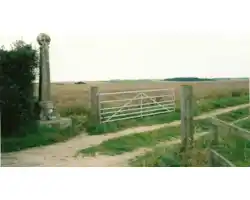28 June 2019
|
While we love our own family histories, they mean so much more with a bit of historical background. Here Steve Roberts runs through the history of those famous families of the Wars of the Roses, aka the Lancastrians and Yorkists. If you need a little refresh of this famous chapter of history, read on…
While we love our own family histories, they mean so much more with a bit of historical background. Here Steve Roberts runs through the history of those famous families of the Wars of the Roses, aka the Lancastrians and Yorkists. If you need a little refresh of this famous chapter of history, read on…
Mrs Steve and I were married in August 1984, so the month of August would often find us ensconced in some hotel or B&B, celebrating an anniversary. Being a man with history in his head, and the person with the responsibility for finding somewhere ‘suitable’, our destination would often be a place with a story … or four.
Take 1993, when we rocked up in Lincolnshire for four nights. Now, we could have headed to many places in the UK and found the ‘Wars of the Roses’, but our jollies would often have us following in the footsteps of one enigmatic personage, Richard Duke of Gloucester, or Richard III as he became.
Beginning with Henry Bolingbroke
It wasn’t Richard we found first though, but the man who started our tale of Lancastrians and Yorkists, Henry Bolingbroke (Henry IV). It was late on a Wednesday when we arrived at the ruins of Old Bolingbroke Castle, the place which gave Henry his rather splendid appellation (or name). I went for a clamber. Mrs Steve, worn out by the exertions of the day, remained in the car and had a nap. I sense that many readers are nodding with approval. ‘Bowling Ball’ was the first of the Lancastrian kings and nemesis of Richard II. The Lancastrians would have it all their own way for a while, but my man Richard Duke of Gloucester would eventually be waiting in the wings.
Richard’s rise to power
On the Friday morning we were in Grantham looking for coffee and something of the tea-cake or fruit scone persuasion. My research guided us not to any indiscriminate coffee house, but to the Angel & Royal, where Richard Duke of Gloucester himself held court in the tumultuous autumn of 1483. When his eldest brother, Edward IV, unexpectedly perished in the April, everyone expected his 12-year-old son, another Edward, to succeed, albeit with seasoned bods to guide him. It wasn’t to be. In a sweeping series of events, it was Richard Duke of Gloucester who got his hands on the Crown – enter Richard III. Young Edward (and his little Bruv) headed for the Tower and anyone who opposed the new natural order got their comeuppance, courtesy of a bloody axe.
Supping my coffee in the Angel & Royal, I felt close to the man who represents one of the bookends of the Wars of the Roses (the one at the end). Richard’s death in August 1485 at the Battle of Bosworth is often depicted as the end of an era, the end of the wars, the end of the Plantagenets, the start of the Tudors et al.
It was here, however, in this place – in Grantham – that the message was first rammed home to Richard III that his reign would be ‘troubled’. His erstwhile buddy, the Duke of Buckingham, had turned traitor and was now allied with the last Lancastrian hope, Henry Tudor. Richard III’s wrath knew no bounds, as he raged against the Duke, ‘the most untrue creature living’, and summoned his great seal. On this occasion, Richard got away with it. The rebellion foundered, undone in part by the British weather (some things change little). Buckingham was another to hear the ‘swoosh’ of a descending axe-blade. Richard survived … for now.
A year later in Leicester
A year later on a stay-away and Mrs Steve and I were getting to the heart of the story. We arrived in Ashby-de-la-Zouch.
Now, Leicestershire was, of course, the county where it all finally went belly-up for Richard when his tactics (and supporters) failed him at Bosworth.
We headed to Leicester first, which Richard and his supporters advanced out of on their way to face Henry Tudor. There was a statue of Richard III, which has been moved to Cathedral Green since we saw it, presumably to put it closer to his tomb, which resides in the cathedral, the bashed-up remains of the monarch having been famously found under a car park. We also found a pair of plaques at the bridge over the River Soar, which Richard’s mighty force clattered over on its way to fierce confrontation. One of those plaques dated to 1856 and recorded that the king’s remains lay close by (for a long time it was believed that his remains had been dumped in the river: we know otherwise today, of course).
Ruined castle, ruined dreams
At Kirby Muxloe, we found the ruins of a castle in a picturesque, moated setting. This was a grand fortified house being built by Lord Hastings, when he became collateral damage during Richard’s coup d'état of 1483. The elimination of Hastings was so hasty and spur of the moment that there wasn’t even time to procure a block for the axeman. Off with his head though. Hastings’ grand house would never be finished and would be reclaimed by nature, a lament for the troubled times England was enduring.
Donington le Heath Manor House has a large four-poster that is reputedly Richard III’s bed. The story goes that Richard slept in this very bed at the Blue Boar Inn, Leicester, before heading off to Bosworth. Camped at the field, awaiting battle, he no doubt slept in some form of camp bed, tortured by nightmares, according to Shakespeare. Donington was owned by the Digby family in the 15th century and Sir John Digby fought against Richard at Bosworth, which is, presumably, how the great bed came back here, as a ‘spoil of war’.
Back to Bosworth
Of course, we had to revisit Bosworth, where Richard’s final denuouement occurred. It was my third visit. I’d first been here in the early-1980s, when still a bachelor, and non-driver. I’d got the train and opted to walk from Nuneaton, not appreciating that it was an 18-mile round yomp. The second time saw Mrs Steve and I, and her parents, attend the battle re-enactment staged for the 500th anniversary in 1985.
Fotheringhay – where Richard’s story began
We said farewell to Ashby, but not to Richard, as we headed into the neighbouring county of Northamptonshire. It was at the castle of Fotheringhay that Richard’s story began: he was born here in October 1452. Now, the tour guide had done well here. Our B&B overlooked the River Nene and had the castle ruins in its grounds. There’s a motte and a bit of fenced off wall, the fence sporting a couple of plaques (birthplace of Richard III, place of execution of Mary, Queen of Scots).
Fotheringhay has historical importance far exceeding its size. This modest little village is the burial place of royals, for its castle became a family fortress of the Yorkists. Richard’s father, the Duke of York was reburied in the church in 1476, and his mother, Cecily Neville, also lies here, along with one of his sons, Edmund, Earl of Rutland, who perished with his Dad at the Battle of Wakefield (1460). It was a funny feeling, having walked the battlefield where Richard III died only the evening before, to now be at the castle where’d he’d emerged into the world.
Of course, a king getting thoroughly duffed up in battle (to the extent of being killed) is never recommended. Not only do you lose your life, crown (and bed in Richard’s case), but you also permit your enemies to write whatever they like about you. The Tudor scribes, including Shakespeare, made hay, trashing Richard’s reputation. He was the killer of the Princes in the Tower, Henry VI, his brother Clarence, his wife, Anne Neville.... As I sat on the motte, I reflected on the worst of the propaganda, that he’d been born a monster, with teeth.
The country’s least-known ‘Regis’
After we finally left Fotheringay, we stopped off at nearby Grafton Regis. It’s perhaps this country’s least-known ‘Regis’. It was here that Edward IV secretly married Elizabeth Woodville in 1464, an event that eventually precipitated the succession crisis of 1483, that led to Richard III seizing the throne. Elizabeth Woodville was born here and later snared a king. It is these little-known events that occurred in obscure places that make this nation’s history what it is: endlessly fascinating.
Yorkshire: Richard’s county
Another August (2004) saw us in Yorkshire, the county most associated with Richard, who had his favourite castle at Middleham, and a lot of supporters in this part of the world. He had his son (yet another Edward) unveiled as his heir (and Prince of Wales) in York Minster in September 1483, not long before it all began to unravel for him – in the form of the Duke of Buckingham.
One place we drove to was Towton, the site of the bloodiest battle of the Wars of the Roses. When this battle was fought, our Richard was eight years of age. This was the era when his eldest brother was in his pomp and Towton was the single event that effectively guaranteed him the crown. That day, in a blinding snowstorm, the Lancastrians were cut down in their thousands. Perhaps we need to be a little circumspect about not only Shakespeare, but also Tudor scribes who would have us believe that Richard was an out and out rotter (and a sword-wielding eight-year-old).
Good king… or bad king?
We’d been up in Nottinghamshire for a few days later in 2004 and, on our way home, diverted to Stony Stratford, in Buckinghamshire. This place featured significantly in Richard’s 1483 coup, for it was here, at the former ‘Rose & Crown Inn’, where he took possession of the young Edward, who was destined (not) to succeed his father, Edward IV. The building is no longer a hostelry these days but does have a plaque recording the momentous events that occurred here. Not only did Richard get his hands on the Prince, he also arrested a few Woodvilles, who’d been escorting the youngster to London for his coronation. The axe would require sharpening again.
Richard’s reputation (good king or bad king) really hinges on what we think happened to the Princes in the Tower and who it was who ordered them to be disposed of. This is the most serious crime laid at Richard’s door by those who would discredit him. The jury remains out.
Gazing at a modern tomb in Leicester Cathedral, I was haunted by the recollection that I had once vowed I would solve the mystery of the Princes in the Tower and thereby clear Richard’s name of the most heinous crime of which he has been accused. I was younger then, idealistic, and not appreciating how difficult these quests can be. As I stared at the slab and Richard’s motto, ‘Loyalty Binds Me’, I felt it was time to reaffirm my vow and commence again my search for that shred of evidence …
KINGS in BATTLE
English (and British) kings in battle
1066 – Harold II, the last English king to die in battle, until …
1485 – Richard III, assumes the unwanted tag-line, ‘the last English king to die in battle’.
1513 – James IV, King of Scotland, becomes the last British king to die in battle, at Flodden.
1743 – At Dettingen, George II becomes the last British monarch to lead his troops in battle.
Have you made a family history or history trip, and would like to share your story and pictures? Please email [email protected] and we'd love to add them to our website.
To read more abour the Yorkist and Lancastrian history, see Steve Roberts' article in the August 2019 issue of Family Tree, in the shops from 2 July 2019.















